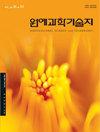基于模型的番茄水培温室冬季通风量、植物二氧化碳吸收率及通风供气CO2量计算
IF 0.8
4区 农林科学
Q3 HORTICULTURE
Korean Journal of Horticultural Science & Technology
Pub Date : 2023-08-31
DOI:10.7235/hort.20230035
引用次数: 0
摘要
本研究旨在利用模型方程计算番茄增效温室冬季通风CO2 (CO2)和植株吸收CO2,以预测当前CO2浓度和下一个CO2供应。从2022年1月18日到3月12日,从上午10点到下午13点,使用以液化石油气(LPG)为原料的CO2型肥料,提供目标浓度(600 μmol·mol-1)的CO2。在温室温度16 ~ 34℃、相对湿度65 ~ 93%条件下,通风量为9.66 ~ 26.49 m3·m-2·h-1。外部温度为3 ~ 20℃,外部相对湿度为42 ~ 95%。计算净同化速率为5.6 ~ 11.1 g·m-2·h-1,通风CO2量为1.35 ~ 3.88 g·m-2·h-1。当CO2施肥开始时CO2浓度(Ci)低于目标CO2浓度(Cg)时,计算得到的第一次CO2供供量为17.79 ~ 28.18 g·m-2·h-1。当供气th后某一时刻CO2浓度(Ct)低于目标CO2浓度(Cg)时,下一次CO2供气在3.0 ~ 32.6 g·m-2·h-1之间。结果表明,在PPFD浓度为400 μ mol·m-2·s-1时,CO2浓度为600 μ mol·mol-1时,光合速率增加最多,而在PPFD浓度高于600 μ mol·m-2·s-1时,CO2浓度为800 μ mol·mol-1时,光合速率增加最多。综上所述,在光照强度较低的冬季,超过800μmol·mol-1的CO2供给量不会成比例地增加净同化速率;因此,CO2供应效率似乎更多地受到通风CO2损失而不是净同化率的影响。这些模型方程可用于控制温室温室的CO2施肥,以提高水果蔬菜的产量。本文章由计算机程序翻译,如有差异,请以英文原文为准。
Model-based Calculations of Ventilation Rate, Carbon Dioxide (CO2) Absorption Rate by Plants, and Amounts of Ventilated and Supplied CO2 for Tomato Hydroponic Greenhouse during a Winter Season
This study aimed to calculate ventilated carbon dioxide (CO2) and CO2 absorption by plants in a carbon dioxide (CO2) supplemental greenhouse for tomato cultivation during the winter season using a model equation in order to predict the current CO2 concentration and next CO2 supply. A targeted CO2 concentration (600 μmol·mol-1) was supplied from 10 a.m. to 13 p.m. from January 18, 2022 to March 12, 2022 using a CO2 type of fertilizer operated with LPG (liquefied petroleum gas). The ventilation rate ranged from 9.66 to 26.49 m3·m-2·h-1 at greenhouse temperature of 16 to 34°C and relative humidity (RH) of 65 to 93%. The external temperature was in the range of 3 to 20°C and external RH was 42 to 95%. The calculated net assimilation rate was in the range of 5.6 to 11.1 g·m-2·h-1, and the amount of ventilated CO2 ranged from 1.35 to 3.88 g·m-2·h-1. When the CO2 concentration (Ci) was lower than the target CO2 concentration (Cg) at the starting time of CO2 fertilization, the calculated first CO2 supply was in the range of 17.79 to 28.18 g·m-2·h-1. When the CO2 concentration at a certain time (Ct) was lower than the targeted CO2 concentration (Cg) after t hours of supply, the next CO2 supply was between 3.0 and 32.6 g·m-2·h-1. The photosynthesis rate measured at the 83 DAT showed the maximum increase with the 600 µmol·mol-1 of CO2 supplement under the 400 µmol·m-2·s-1 of PPFD, whereas the 800 µmol·mol-1 of CO2 supplement results into its maximum increase under all the PPFD levels higher than 600 µmol·m-2·s-1. Integrating all of the results suggests that during the winter season given the low light intensity, a CO2 supply exceeding 800μmol·mol-1 does not proportionally increase the net assimilation rate; thus, the CO2 supply efficiency appears to be affected more by the ventilated CO2 loss than by the net assimilation rate. These model equations can be used to control the CO2 fertilization in order to improve the yields of fruit vegetables in greenhouses.
求助全文
通过发布文献求助,成功后即可免费获取论文全文。
去求助
来源期刊
CiteScore
2.00
自引率
0.00%
发文量
0
审稿时长
1 months
期刊介绍:
Horticultural Science and Technology (abbr. Hortic. Sci. Technol., herein ‘HST’; ISSN, 1226-8763), one of the two official journals of the Korean Society for Horticultural Science (KSHS), was launched in 1998 to provides scientific and professional publication on technology and sciences of horticultural area. As an international journal, HST is published in English and Korean, bimonthly on the last day of even number months, and indexed in ‘SCIE’, ‘SCOPUS’ and ‘CABI’. The HST is devoted for the publication of technical and academic papers and review articles on such arears as cultivation physiology, protected horticulture, postharvest technology, genetics and breeding, tissue culture and biotechnology, and other related to vegetables, fruit, ornamental, and herbal plants.

 求助内容:
求助内容: 应助结果提醒方式:
应助结果提醒方式:


